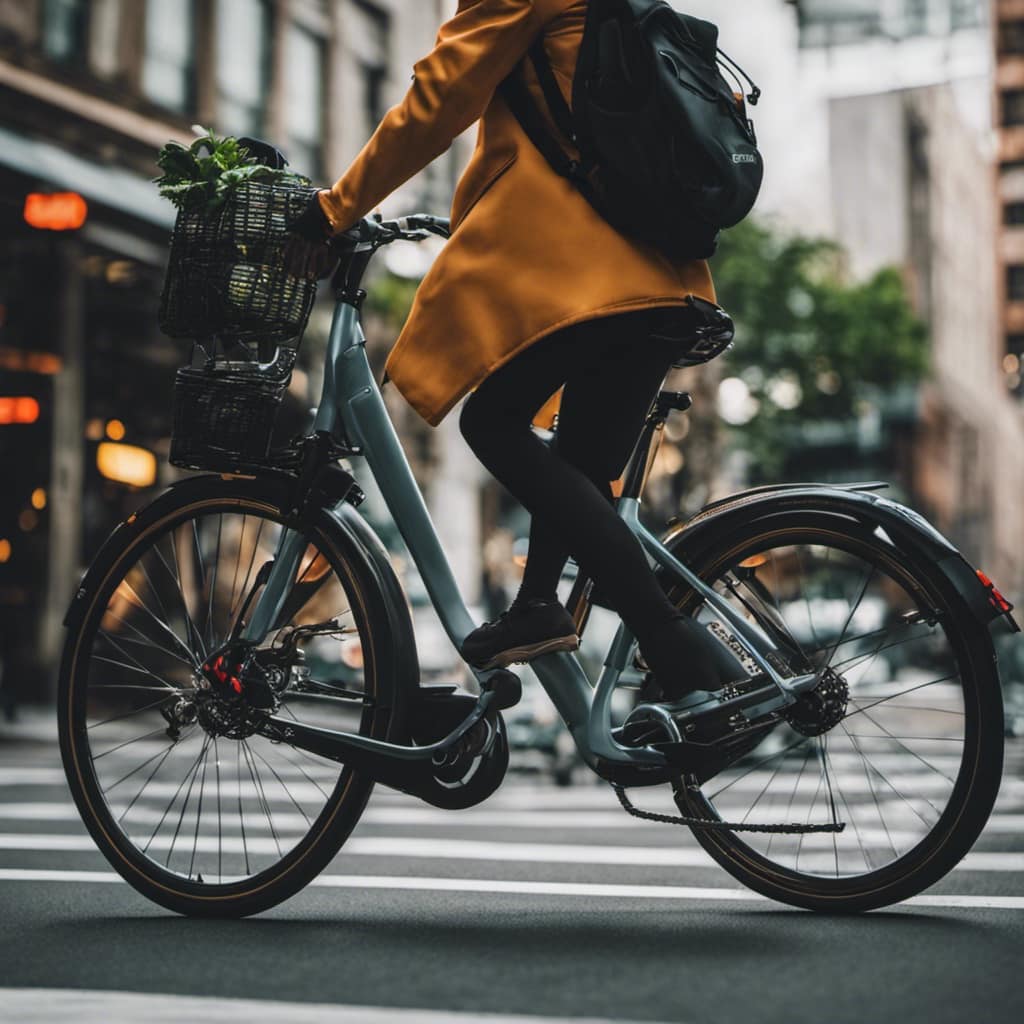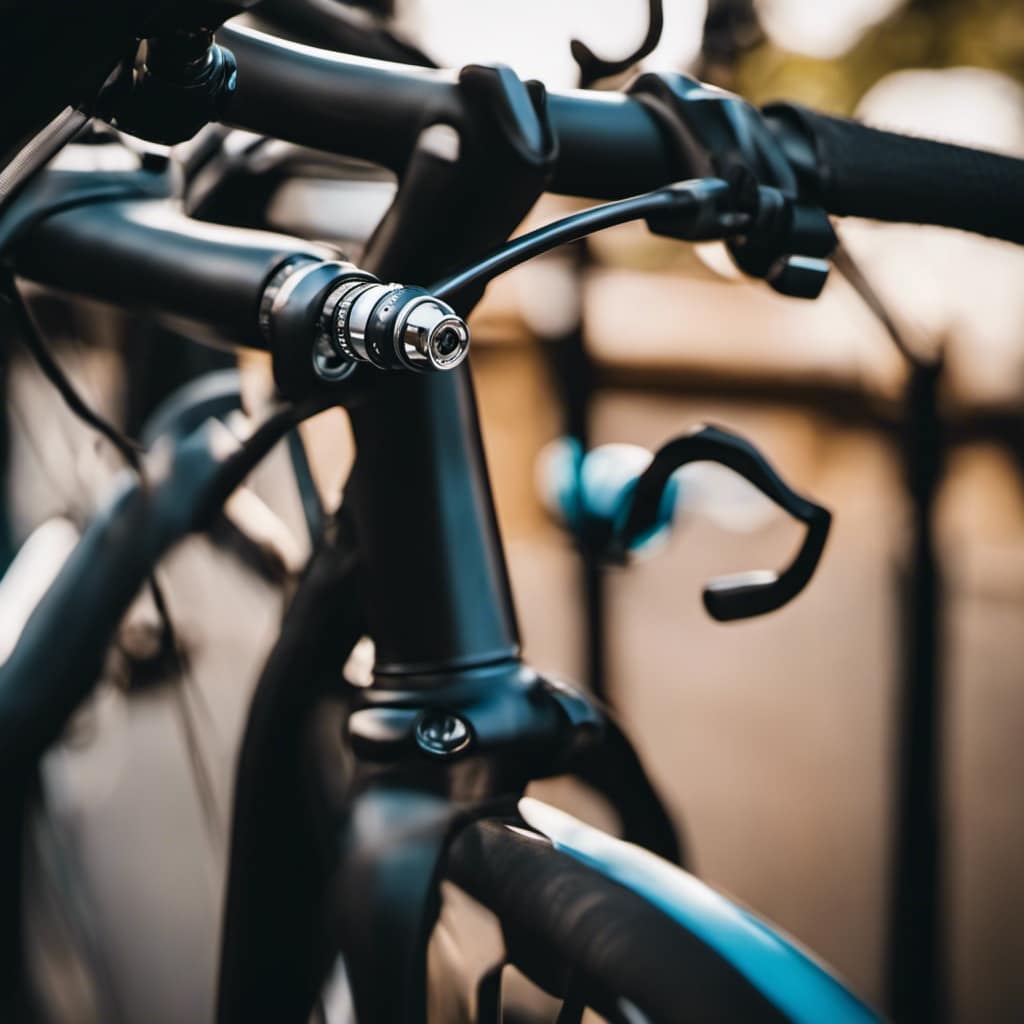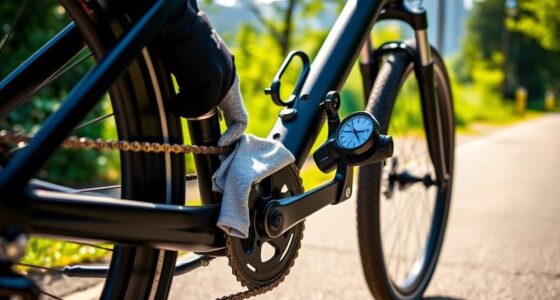Looking to take your commuter hybrid bike to the next level? Look no further! We’ve got 12 essential upgrade options that will revolutionize your riding experience.
From upgraded tires for smoother rides to an advanced GPS navigation system for effortless navigation, we’ve got you covered.
With our detailed and passionate recommendations, you’ll be able to customize your bike to fit your needs and desires.
Get ready to liberate your daily commute and enjoy the ride like never before.
Key Takeaways
- Upgraded Tires, Enhanced Braking System, Improved Suspension, and Lightweight Frame Options are essential upgrades for a smoother and more comfortable ride on your commuter hybrid bike.
- Upgrading the gearing system, using ergonomic handlebars, having a comfortable saddle, and efficient pedals can significantly improve the performance and efficiency of your bike.
- Safety upgrades like an integrated lighting system and reliable fenders are crucial for a safer riding experience.
- Practical upgrades such as a practical bike rack and ensuring compatibility with your bike are important for transportation and storage convenience.
Upgraded Tires
We’ve found that with upgraded tires, our rides on our commuter hybrid bikes have become smoother and more enjoyable.
One of the key upgrades we made was to invest in puncture resistant tires. These tires are designed to withstand sharp objects on the road, reducing the risk of getting a flat tire. We no longer have to worry about encountering glass shards or nails during our daily commute.
Additionally, we upgraded the suspension on our bikes to further enhance the comfort of our rides. The upgraded suspension absorbs bumps and shocks, providing a smooth and stable ride on uneven terrain. Whether we’re navigating potholes or riding over gravel, the upgraded tires and suspension work together to ensure a liberating and stress-free biking experience.
Enhanced Braking System
One of the most crucial upgrades we made to our commuter hybrid bikes was enhancing the braking system, providing us with increased control and safety while riding.
Here are three reasons why upgrading your brake system is essential for a liberating biking experience:
-
Upgraded Brake Pads: By investing in high-quality brake pads, we noticed a significant improvement in stopping power and responsiveness. These upgraded brake pads offer better grip and durability, ensuring a safer ride even in wet or slippery conditions.
-
Hydraulic Disc Brakes: Upgrading to hydraulic disc brakes revolutionized our biking experience. The smooth and consistent braking provided by hydraulic systems significantly enhances control and modulation. With hydraulic disc brakes, we could effortlessly and precisely apply the desired amount of braking force, giving us the confidence to navigate any terrain.
-
Enhanced Safety: The combination of upgraded brake pads and hydraulic disc brakes offers unparalleled safety on the road. Whether it’s sudden stops or navigating steep descents, these enhancements provide the peace of mind and control needed for a truly liberating biking adventure.
Investing in an enhanced braking system is a game-changer for any commuter hybrid bike, offering increased safety, control, and overall biking enjoyment.
Improved Suspension
As we explore upgrade options for our commuter hybrid bikes, a subtopic that deserves attention is how improved suspension can enhance our riding experience. Upgrading the suspension of our bikes can provide us with improved shock absorption, allowing us to navigate rough terrains and bumpy roads with ease. One option to consider is an adjustable suspension system, which gives us the freedom to customize our ride based on our personal preferences and the type of terrain we encounter. This means we can have a softer suspension for a smoother ride on city streets, and a stiffer suspension for more control and stability on off-road trails. With improved suspension, we can enjoy a more comfortable and dynamic riding experience, giving us the freedom to explore new routes and push our limits.
| Suspension Type | Benefits | Compatible Bikes |
|---|---|---|
| Air Suspension | Excellent shock absorption, adjustable, lightweight | Mountain, gravel, and hybrid bikes |
| Coil Suspension | Durable, cost-effective, suitable for heavier riders | Mountain and hybrid bikes |
| Suspension Fork | Smooth ride, absorbs impact, improves control | Road, hybrid, and electric bikes |
Upgrade your bike’s suspension system and experience the freedom to conquer any terrain with confidence and comfort.
Lightweight Frame Options
When it comes to lightweight frame options for your commuter hybrid bike, there are two main contenders: carbon and aluminum.
Both materials have their advantages and it ultimately comes down to your personal preferences and budget.
Carbon frames are known for their lightness and ability to absorb vibrations, offering a smooth and comfortable ride.
Aluminum frames, on the other hand, are more affordable and still provide a good balance between weight and performance.
Carbon Vs Aluminum
We prefer the lightweight carbon frame over the aluminum option for our commuter hybrid bike. Carbon frames offer several advantages that make them a superior choice for riders seeking a liberating experience on their daily commute.
Here are three reasons why carbon frames are the way to go:
-
Weight: Carbon frames are incredibly light, making them perfect for those looking to optimize their bike’s performance. With a lighter frame, you’ll experience improved acceleration and maneuverability, allowing you to effortlessly navigate through traffic and conquer hills with ease.
-
Stiffness: Carbon frames possess excellent stiffness, ensuring that power transfer from your legs to the pedals is maximized. This translates to an efficient ride, enabling you to maintain a higher average speed and reduce fatigue during long commutes.
-
Vibration Damping: Carbon frames are known for their exceptional ability to absorb road vibrations. This means a smoother and more comfortable ride, reducing fatigue and allowing you to arrive at your destination feeling refreshed and liberated.
Weight and Performance
Our top choice for a lightweight frame option is the carbon frame. Carbon frames are known for their exceptional strength-to-weight ratio, making them the ideal choice for riders looking to reduce weight and enhance performance. With a carbon frame, you can enjoy a lighter bike without compromising on durability or rigidity.
The reduced weight allows for easier maneuverability and faster acceleration, making your daily commute a breeze. Additionally, a lighter bike puts less strain on your body, allowing you to ride longer and more comfortably. When paired with other weight reduction bike accessories, such as carbon handlebars or a carbon seat post, you can achieve a significant decrease in overall weight, resulting in a more efficient and enjoyable ride.
Transitioning into the next section, let’s now explore the benefits of upgrading to an enhanced gearing system.
Upgraded Gearing System
One of the first upgrades we recommend for your commuter hybrid bike is a new gearing system. Upgrading your drivetrain can greatly enhance your riding experience and make your commute more efficient and enjoyable.
Here are three key reasons why you should consider upgrading your gearing system:
-
Improved Gear Ratio: Upgrading your gearing system allows you to fine-tune your gear ratios, providing a wider range of options for different terrains and riding conditions. This means you can find the perfect gear for both uphill climbs and speedy descents, making your ride smoother and more efficient.
-
Enhanced Shifting Performance: Upgraded drivetrains often come with improved shifting mechanisms, resulting in quicker and more precise gear changes. This ensures a seamless transition between gears, allowing you to maintain your momentum and power without any interruptions.
-
Reduced Maintenance: Upgraded gearing systems often come with more durable components, reducing the need for frequent repairs and adjustments. This means less time spent in the bike shop and more time out on the road, enjoying your liberating commute.
With an upgraded gearing system, you’ll be ready to conquer any terrain and ride with confidence.
Now, let’s move on to the next essential upgrade: ergonomic handlebars.
Ergonomic Handlebars
When it comes to upgrading your commuter hybrid bike, one essential option to consider is ergonomic handlebars. These handlebars are designed with the rider’s comfort in mind, providing a more natural and relaxed grip position.
Not only do they improve riding comfort, but they also offer better control and stability, allowing you to navigate through traffic or rough terrains with ease.
Improved Riding Comfort
We highly recommend upgrading your commuter hybrid bike with ergonomic handlebars for improved riding comfort. When it comes to long rides or daily commutes, having handlebars that fit your hands perfectly can make a world of difference. Here are three reasons why ergonomic handlebars are a must-have for your bike:
-
Reduced strain on your wrists: Ergonomic handlebars are designed to align with the natural curve of your wrists, reducing the strain and discomfort that can occur during rides. This is especially important for those with wrist issues or carpal tunnel syndrome.
-
Enhanced shock absorption: Combined with an upgraded seatpost and shock absorption technology, ergonomic handlebars help to absorb road vibrations and bumps, providing a smoother and more comfortable ride. No more jarring impacts on your hands and arms!
-
Improved posture and control: Ergonomic handlebars promote a more upright riding position, which not only improves comfort but also gives you better control and stability over your bike. This is particularly beneficial when navigating through traffic or maneuvering tight corners.
Better Control and Stability
As we explore the topic of better control and stability with our commuter hybrid bike, it is essential to consider upgrading to ergonomic handlebars for a more secure and comfortable grip. Ergonomic handlebars are designed to enhance stability and provide improved handling, allowing you to have better control over your bike in various riding conditions.
By investing in ergonomic handlebars, you can experience a range of benefits, including reduced hand fatigue and increased comfort during long rides. The ergonomic design promotes a more natural hand position, alleviating stress on your wrists and arms.
To help you understand the advantages of ergonomic handlebars, here is a comparison table highlighting the key features:
| Feature | Benefits |
|---|---|
| Wider Grip | Enhanced stability and control |
| Angled Design | Improved wrist alignment and reduced strain |
| Gel Padding | Increased comfort and reduced hand fatigue |
| Adjustable Length | Customizable fit for individual preferences |
| Integrated Bar Ends | Additional hand positions for varying terrain |
Upgrade your commuter hybrid bike with ergonomic handlebars to enjoy a more comfortable and controlled riding experience. Experience the freedom of enhanced stability and improved handling, making your daily commute a joyous and liberating adventure.
Comfortable Saddle
Fortunately, we’ve found that upgrading to a more comfortable saddle greatly enhances our riding experience. When it comes to long commutes or leisurely rides, having a saddle that provides adequate support and cushioning is essential for a liberating and enjoyable journey.
Here are three options to consider when upgrading your saddle:
-
Ergonomic Padding: Opting for a saddle with ergonomic padding ensures that pressure is distributed evenly across your sit bones. This reduces discomfort and prevents numbness, allowing you to ride longer and with less fatigue.
-
Gel Padding: Gel padded saddles offer an extra layer of cushioning, providing a plush and comfortable seating experience. The gel molds to your body shape, providing optimal support and reducing pressure points, resulting in a smooth and pain-free ride.
-
Cut-Out Design: Saddle designs with a cut-out or groove in the center help to relieve pressure on sensitive areas. This feature promotes better blood flow and reduces the risk of numbness or discomfort, allowing you to ride with freedom and confidence.
Investing in a comfortable saddle is a small but significant upgrade that will enhance your riding experience, making every journey a pleasurable and liberating one.
Efficient Pedals
Upgrading to pedals with efficient power transfer is a game-changer for improving our cycling performance. Clipless pedals, which allow us to securely attach our cycling shoes to the pedals, are a popular choice for riders looking to maximize power transfer. By eliminating the need to constantly reposition our feet on the pedals, clipless pedals allow us to maintain a more efficient pedaling motion. They also provide a more stable connection between our feet and the bike, resulting in improved control and stability.
With clipless pedals, we can transfer more power from our legs to the bike, enabling us to ride faster and with less effort. This upgrade is essential for those seeking to enhance their overall cycling experience.
Speaking of enhancements, let’s now explore the next upgrade option: an integrated lighting system.
Integrated Lighting System
For our commuter hybrid bike, one of the most important upgrades is adding an integrated lighting system. Not only does it enhance bike safety, but it also improves visibility and convenience during your rides.
Here are three reasons why an integrated lighting system is a must-have upgrade:
-
Enhanced Safety: With a built-in lighting system, you can be easily seen by other road users, especially during low-light conditions or at night. This significantly reduces the risk of accidents and ensures a safer commute.
-
Improved Visibility: Integrated lights are strategically placed on your bike, making you more visible from all angles. This helps you stand out in traffic, giving you the confidence to navigate through busy streets with ease.
-
Convenience: No more hassle of attaching and removing lights every time you ride. An integrated lighting system stays permanently on your bike, always ready to illuminate your path without any additional effort.
Investing in an integrated lighting system not only enhances your safety but also adds convenience to your daily commute. Stay visible, ride confidently, and enjoy the liberation of a well-lit journey.
Reliable Fenders
Adding reliable fenders to our commuter hybrid bike is a practical choice for protecting ourselves from splashes and dirt while riding in wet conditions. Not only do they keep us dry and clean, but they also improve our riding comfort. Reliable fenders are designed to effectively block water and mud from splashing up onto our bodies, keeping our clothes and shoes free from dirt and moisture. This allows us to ride with ease and confidence, knowing that we won’t end up soaked and dirty after a rainy commute. With improved riding comfort, we can truly enjoy the freedom and liberation that comes with biking, regardless of the weather conditions.
| Pros | Cons |
|---|---|
| Shields us from splashes and dirt | Additional weight on the bike |
| Keeps our clothes and shoes clean | Requires installation |
| Improves riding comfort | May require adjustments for proper fit |
| Enhances bike aesthetics | Limited color and design options |
| Easy to clean | May interfere with certain bike accessories |
Practical Bike Rack
When it comes to finding the best bike rack for your commuter hybrid bike, there are a few key points to consider.
First, you want a rack that’s sturdy and reliable, able to securely hold your bike during your daily commute.
Additionally, installation tips can be helpful to ensure that the rack is properly installed and won’t cause any issues during your rides.
Lastly, compatibility with your bike is crucial, as not all racks are suitable for every type of bike.
Best Bike Rack
We highly recommend considering the installation of a practical bike rack as an essential upgrade for our commuter hybrid bikes. Having a reliable bike rack allows us to transport our bikes easily and securely, giving us the freedom to explore new routes and destinations.
Here are three top-notch bike rack options to consider:
-
Thule T2 Pro XT Bike Rack: This rack offers easy installation and can accommodate up to two bikes. It features a tool-free attachment system and a secure ratcheting arm to hold our bikes in place.
-
Yakima HoldUp Evo Bike Rack: With its sturdy construction and versatile design, this rack can carry different bike types. It has an easy-to-use tilt feature, making it convenient to access our vehicle’s trunk.
-
Saris Superclamp EX Bike Rack: This rack is known for its compact design and user-friendly installation process. It can carry up to four bikes and has adjustable trays to accommodate various bike sizes.
Investing in a practical bike rack ensures that we can transport our bikes safely and conveniently, enhancing our overall biking experience.
Installation Tips
For proper installation of a practical bike rack, we recommend following these helpful tips.
-
Start by selecting a rack that’s compatible with your bike’s frame and can accommodate the weight of your bike.
-
Before installation, thoroughly clean the area where the rack will be attached.
-
Use the appropriate tools to securely fasten the rack to your bike’s frame, ensuring that it’s level and tightly secured.
-
Additionally, regularly check and tighten the bolts to maintain the stability of the rack.
-
To prolong the life of your bike rack, apply a rust-resistant coating and regularly clean it to remove dirt and debris.
Compatibility With Bike
Our hybrid bike needs to have compatibility with a practical bike rack in order to securely transport our belongings while commuting. Here are three maintenance tips to ensure that our bike is compatible with a bike rack:
-
Frame Compatibility: Check if our bike frame has the necessary mounting points for a bike rack. Most hybrid bikes have eyelets on the rear dropout and seat stays where we can attach a rack. If our bike doesn’t have these eyelets, we can consider using a seatpost-mounted rack or a rack that attaches to the bike’s seat tube.
-
Weight Capacity: Make sure to check the weight capacity of the bike rack. We need to consider the weight of our belongings and ensure that the rack can handle the load without compromising stability or safety.
-
Adjustability: Look for a bike rack that’s adjustable to fit different sizes and types of bikes. This will allow us to easily switch the rack between different bikes if needed.
Advanced GPS Navigation System
One of the most important upgrade options for our commuter hybrid bike is installing an advanced GPS navigation system. Having a reliable and accurate GPS system can greatly enhance our commuting experience, providing us with accurate directions and real-time traffic updates. The GPS accuracy ensures that we never miss a turn or get lost, giving us the freedom to explore new routes and discover hidden gems in our city. Additionally, a long battery life is crucial to ensure uninterrupted navigation throughout our journeys. To help you make an informed decision, here’s a comparison table showcasing some of the top GPS navigation systems available for our commuter hybrid bikes:
| GPS Navigation System | GPS Accuracy | Battery Life |
|---|---|---|
| Garmin Edge 530 | High | Up to 20 hours |
| Wahoo ELEMNT BOLT | High | Up to 15 hours |
| Lezyne Mega C | High | Up to 32 hours |
| Bryton Rider 15 | Moderate | Up to 16 hours |
| Polar V650 | Moderate | Up to 10 hours |
Investing in an advanced GPS navigation system will provide us with the freedom to explore, while ensuring accurate navigation and a long-lasting battery life.
Conclusion
After exploring the various upgrade options for your commuter hybrid bike, it becomes clear that investing in these enhancements can truly transform your riding experience.
From upgraded tires and enhanced braking systems to advanced GPS navigation and integrated lighting systems, these upgrades won’t only improve your bike’s performance but also ensure a safer and more enjoyable commute.
So, why not take your bike to the next level and unlock its full potential?
It’s time to ride with confidence and embrace the thrilling possibilities that await you on your daily journeys.
















